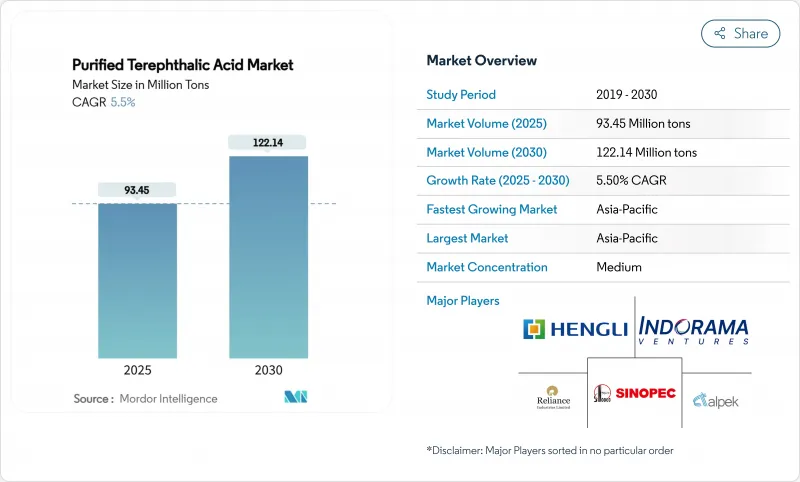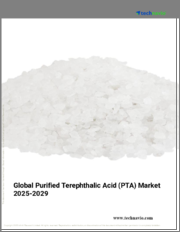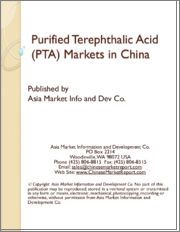
|
시장보고서
상품코드
1849925
고순도 테레프탈산 : 시장 점유율 분석, 산업 동향, 통계, 성장 예측(2025-2030년)Purified Terephthalic Acid - Market Share Analysis, Industry Trends & Statistics, Growth Forecasts (2025 - 2030) |
||||||
고순도 테레프탈산 시장 규모는 2025년에 9,345만 톤으로 평가되었고, 2030년에 1억 2,214만 톤에 이를 것으로 예측되며, 예측기간(2025-2030년)의 CAGR은 5.5%를 나타낼 전망입니다.

포장, 섬유 및 신흥 자동차 최종 사용 분야 전반에 걸친 강력한 폴리에틸렌 테레프탈레이트(PET) 수요가 성장을 뒷받침하고 있으며, 성숙 지역에서 생산 능력 재편이 진행 중임에도 불구하고 이러한 추세는 지속되고 있습니다. 중국과 인도의 석유화학 체인 통합은 비용 경쟁력을 강화하고 있으며, 화학 재활용 기술은 새로운 원료 공급원과 프리미엄 가격 풀을 창출하고 있습니다. 원료 가격 변동성은 독립 생산자의 마진을 축소시키고 있어, 후방 통합 및 운영 효율성 향상을 위한 가시적인 전환을 촉진하고 있습니다. 특히 유럽연합(EU)을 중심으로 PET 포장재의 재활용 함량 확대를 위한 규제 강화가 조달 전략을 재편하고 폐쇄형 시스템 투자를 촉진하고 있습니다.
세계의 고순도 테레프탈산 시장 동향 및 인사이트
전자상거래 분야에서 PET 포장의 왕성한 수요
전자상거래 배송 포맷은 자동 분류 및 장거리 운송 주기를 견딜 수 있는 경량 PET 용기를 선호하여 고급 PTA 수요를 촉진하고 있습니다. 인도 및 동남아시아 브랜드들은 소비자 직배송이 급증하는 시기에 탄산과 풍미를 보존하는 차단 기능 강화 병을 도입하고 있습니다. 싱글스 데이, 디왈리 같은 분기별 프로모션은 갑작스러운 PTA 발주를 유발하여 지역 재고를 타이트하게 유지하고 현물 프리미엄을 지속시키고 있습니다. 북미 식품 및 음료 공급업체들도 택배 운송을 위한 포장재 재설계를 진행 중이며, 이로 인해 내응력균열성 PTA 사양이 상승하고 있습니다. 이러한 설계 변경으로 유리 및 금속 용량이 PET로 전환되며, 정제 테레프탈산 시장은 물량과 가치 측면 모두에서 확대되고 있습니다. 계절적 수요 급증은 변환업체를 PX 가격 변동으로부터 보호하는 공식 기반 가격 책정 방식의 공급 계약을 촉진합니다.
성장하는 폴리에스테르 섬유 생산
중국의 PTA-섬유 통합 단지는 현장 유틸리티 및 물류 시너지를 활용해 대규모로 비용 효율적인 섬유를 공급하며 장기적인 PTA 수요를 주도하고 있습니다. 인도 정유사들도 이에 발맞추고 있습니다. 인도오일은 파니파트에서 PTA 생산 능력을 55만 3,000톤에서 70만톤으로 증설하고 있으며, 2026년 중반까지 파라딥에 120만 톤 규모의 생산 라인을 추가할 예정입니다. 이는 인도가 변동 공급자 역할을 공고히 하는 계기가 될 것입니다. 자동차용 부직포, 지오텍스타일, 기능성 의류는 폴리에스터 섬유의 최종 용도를 지속적으로 다각화하고 있으며, 각각은 소폭의 PTA 불순물 허용 범위를 요구하여 적정한 가격 프리미엄을 형성합니다. 시노펙 이정(Yizheng)의 6만 톤 증설된 폴리부틸렌 테레프탈레이트(PBT)는 PET의 주기성에 대한 완충 역할을 하는 엔지니어링 폴리머로의 전략적 전환을 보여줍니다. 이러한 섬유의 내구재 지향성은 패션 사이클에 비해 정제 테레프탈산 시장의 물량을 보다 안정적으로 유지하는 데 도움이 됩니다.
독성학적 우려
ECHA 등록 서류에 따르면 테레프탈산은 유럽 경제 지역 내 100-100만 톤 생산 규모로 분류되어 폐수 및 분진 노출에 대한 모니터링가 강화되고 있습니다. 경구 LD50 값이 5,000 mg/kg을 초과함에도 불구하고, 최근 생식 독성 연구 결과로 인해 규제 당국은 공장 폐수 모니터링 강화 방안을 제안 중입니다. 고급 처리 시스템을 갖추지 못한 중소 규모 생산자들은 자본 지출 또는 가동 중단 가능성에 직면하여 유럽 내 단기 정제 테레프탈산 시장 생산 능력이 축소될 전망입니다. 또한 EU의 일반 제품 안전 규정(GPSR) 하에서 제조업체들은 시장 진입 전 PTA 유래 완제품의 안전성을 입증해야 하므로 규정 준수 비용도 증가합니다.
부문 분석
2024년 폴리에틸렌 테레프탈레이트(PET)는 전 세계 파생 제품 소비량의 64.18%를 차지하며 정제 테레프탈산 시장 수요의 대부분을 형성했습니다. 통합 기업들은 현장에서 PTA를 PET로 전환하여 전환 마진과 물류 비용 절감을 확보함으로써 경쟁 장벽을 강화합니다. 해당 부문의 예상 연평균 성장률(CAGR) 6.56%는 물량 증가와 함께 핫필, 리필 가능 및 차단 기능 강화 포장용 고부가가치 수지 수요 증가를 반영합니다. 폴리부틸렌 테레프탈레이트(PBT)는 여전히 우수한 내열성을 지닌 특수 파생 제품으로, 시노펙 이정(Yizheng)의 8만 톤 증설은 이 소재의 자동차 및 전자 산업 전망을 부각시킵니다. 폴리트리메틸렌 테레프탈레이트(PTTM)는 탄성 회복력과 부드러움 덕분에 기능성 스포츠웨어 분야에서 틈새 시장을 개척 중입니다.
경제성 분석은 현재 디메틸 테레프탈레이트(DMT)보다 PTA의 직접 에스테르화 방식을 선호합니다. 옥시노바(Oxxynova)가 2022년 독일 DMT 생산 설비를 폐쇄한 것은 구조적 비용 불리함을 부각시켰습니다. 그럼에도 PET 폐기물로부터 99.9% DMT 수율을 달성하는 촉매 공정은 정책 인센티브가 실현될 경우 순환형 DMT 공급망 구축 가능성을 보여줍니다. 전반적으로 PET 통합 전략은 정제 테레프탈산 시장을 계속 주도하는 한편, 고마진 파생제품들은 PET 가격 변동 주기에 대응하는 수익 다각화를 실현하고 있습니다.
지역 분석
아시아태평양 지역은 2024년 전 세계 PTA 소비량의 53.62%를 차지했으며, 중국과 인도의 아로마틱스-폴리에스터 통합 투자에 힘입어 연평균 7.18% 성장할 전망입니다. 중국의 일일 원유 처리량 1,480만 배럴이라는 기록적 수치는 풍부한 PX 공급원을 보장하며, 중국석유화학(Sinopec)의 장쑤성 300만 톤 단일 라인 PTA 공장은 규모의 경제를 상징합니다. 인도는 균형 공급국으로 부상 중이며, 인도석유공사(IndianOil)의 파니파트(Panipat) 및 파라딥(Paradip) 확장 프로젝트로 2026년 중반까지 국내 PTA 생산량이 135만 톤 증가할 전망입니다. 한국과 일본은 고부가가치 수지 및 공정 라이선싱에 집중하는 반면, 동남아시아 생산자들은 원료 공급원과의 근접성과 급증하는 내수 수요를 활용합니다. 이러한 역학은 아시아태평양 지역이 정제 테레프탈산 시장의 엔진룸으로서의 지위를 공고히 합니다.
북미 정제 테레프탈산 시장은 경쟁력 있는 천연가스 액체 원료와 확립된 재활용 인프라의 혜택을 받는다. 탄산음료 대기업의 수요와 자동차용 PET 사용 증가로 가동률은 유지되나, 투자자들이 병목 현상 해소와 파라자일렌 설비와의 통합을 선호함에 따라 신규 초석 설비 증설은 제한적입니다. 유럽은 높은 에너지 비용과 강화된 배출 규제라는 구조적 역풍에 직면해 있습니다. 인도라마의 로테르담 사업 검토와 같은 시설 합리화는 신규 PTA 설비 증설보다 특수 등급 및 재생 원료로의 전환을 시사합니다. 아시아산 PET 수입품에 대한 반덤핑 관세는 일시적 완화책이지만 해당 지역의 원료 불리함을 상쇄하지는 못합니다.
남미와 중동, 아프리카는 신흥 성장 동력으로 부상 중입니다. 브라질의 폴리에스터 산업은 국내 시장 진출을 위해 브라스켐 지분 확보를 노리는 다국적 기업들의 관심을 끌고 있습니다. 중동에서는 사빅(SABIC)의 64억 달러 규모 푸젠 복합단지와 토탈에너지(TotalEnergies)의 110억 달러 규모 아미랄(Amiral) 프로젝트가 정유, PX, PTA 설비를 통합한 후 생산물을 고성장 아시아 시장으로 공급하는 전략을 보여줍니다. 이러한 장기 투자로 정제 테레프탈산(PTA) 시장의 지리적 범위가 점차 확대되며, 수요 집적지와 원료 가용성 간 균형이 맞춰질 전망입니다.
기타 혜택 :
- 엑셀 형식 시장 예측(ME) 시트
- 3개월간의 애널리스트 지원
목차
제1장 서론
- 조사의 전제조건과 시장의 정의
- 조사 범위
제2장 조사 방법
제3장 주요 요약
제4장 시장 상황
- 시장 개요
- 시장 성장 촉진요인
- 전자상거래 부문의 PET 포장 수요가 견조
- 폴리에스테르 섬유 생산 증가
- 자동차 산업에서 PET의 이용 확대
- 재생 PET 순환 의무화
- 배터리 분리막 등급 PTA 사용 증가
- 시장 성장 억제요인
- 독성학적 우려
- 변동성 높은 PX 및 원유 가격
- PEF 및 기타 바이오 폴리머의 부상
- 밸류체인 분석
- Porter's Five Forces
- 공급기업의 협상력
- 구매자의 협상력
- 신규 참가업체의 위협
- 대체품의 위협
- 경쟁도
제5장 시장 규모와 성장 예측
- 유도체별
- 폴리에틸렌테레프탈레이트(PET)
- 폴리부틸렌테레프탈레이트(PBT)
- 폴리트리메틸렌테레프탈레이트(PTT)
- 디메틸테레프탈레이트(DMT)
- 기술별
- PX산화(기존방법)
- 바이오 기반 PTA
- 화학 재활용 기반 PTA
- 용도별
- 포장
- 섬유
- 페인트 및 코팅
- 접착제
- 기타 용도(엔지니어링 플라스틱, 의약품 및 중간체 등)
- 지역별
- 아시아태평양
- 중국
- 인도
- 일본
- 한국
- 기타 아시아태평양
- 북미
- 미국
- 캐나다
- 멕시코
- 유럽
- 독일
- 영국
- 이탈리아
- 프랑스
- 기타 유럽
- 남미
- 브라질
- 아르헨티나
- 기타 남미
- 중동 및 아프리카
- 사우디아라비아
- 남아프리카
- 기타 중동 및 아프리카
- 아시아태평양
제6장 경쟁 구도
- 시장 집중도
- 전략적 동향
- 시장 점유율(%)/랭킹 분석
- 기업 프로파일
- Alpek SAB de CV
- BP plc
- China Petroleum & Chemical Corporation.
- Eastman Chemical Company
- FCFC
- HENGLI PETROCHEMICAL(DALIAN) CHEMICAL CO., LTD.
- Indian Oil Corporation Ltd
- Indorama Ventures Public Company Limited.
- INEOS
- JBF Industries Limited
- LOTTE Chemical Corporation.
- Mitsubishi Chemical Corporation.
- Oriental Petrochemical(Taiwan) Co., Ltd.
- PetroChina Company Limited
- Reliance Industries Limited
- SABIC
- Samnam Petrochemical Co.,Ltd.
제7장 시장 기회와 장래의 전망
HBR 25.11.14The Purified Terephthalic Acid Market size is estimated at 93.45 Million tons in 2025, and is expected to reach 122.14 Million tons by 2030, at a CAGR of 5.5% during the forecast period (2025-2030).

Strong polyethylene terephthalate (PET) demand across packaging, textile and emerging automotive end-uses underpins this expansion, even as mature regions restructure capacity. Integration of petrochemical chains in China and India is reinforcing cost leadership, while chemical recycling technologies are unlocking fresh sources of feedstock and premium price pools. Feedstock volatility is narrowing margins for stand-alone producers, prompting a visible shift toward backward integration and operational efficiencies. Regulatory pushes for higher recycled content in PET packaging, especially in the European Union, are reshaping procurement strategies and spurring investment in closed-loop systems.
Global Purified Terephthalic Acid Market Trends and Insights
Strong PET Packaging Demand from E-commerce Sector
E-commerce shipping formats now favor lightweight PET containers that withstand automated sortation and long transit cycles, driving higher-grade PTA offtake. Brands in India and Southeast Asia are adopting barrier-enhanced bottles that preserve carbonation and flavor during direct-to-consumer delivery peaks. Quarterly promotions such as Singles' Day and Diwali generate sudden PTA call-offs, keeping regional inventories tight and sustaining spot premiums. North American food and beverage suppliers are also redesigning packaging for parcel carriers, lifting PTA specifications for stress-crack resistance. These design changes convert glass and metal volumes to PET, broadening the purified terephthalic acid market in both volume and value terms. Seasonal spikes incentivize supply contracts with formula-based pricing that protect converters from PX price swings.
Growing Production of Polyester Fiber
China's integrated PTA-to-fiber parks leverage onsite utilities and logistics synergies to deliver cost-effective fiber at scale, anchoring long-term PTA demand. Indian refiners are following suit; IndianOil is lifting PTA capacity from 553,000 tons to 700,000 tons at Panipat and adding a 1.2 million-ton line at Paradip by mid-2026, cementing India's role as a swing supplier. Automotive nonwovens, geotextiles and functional apparel continue to diversify end-uses for polyester fibers, each requiring narrow PTA impurity windows that command a modest price premium. Sinopec Yizheng's incremental 60,000 tons of polybutylene terephthalate illustrates strategic migration into engineering polymers that buffer against PET cyclicality. The durable-goods orientation of these fibers supports steadier purified terephthalic acid market volumes compared with fashion cycles.
Toxicological Concerns
ECHA registration dossiers classify terephthalic acid in the 1-10 million-ton production band within the European Economic Area, prompting heightened scrutiny over wastewater and dust exposures. Although oral LD50 values exceed 5,000 mg/kg, newer reproductive studies have led regulators to propose stricter monitoring of plant effluents. Small and mid-size producers lacking advanced treatment systems face capital outlays or possible shutdowns, trimming short-term purified terephthalic acid market capacity in Europe. Compliance costs also rise under the EU's General Product Safety Regulation, requiring manufacturers to document the safety of PTA-derived finished goods before market entry.
Other drivers and restraints analyzed in the detailed report include:
- Growing Utilization of PET from Automotive Industry
- Recycled-PET Loop Mandates
- Volatile PX & Crude Prices
For complete list of drivers and restraints, kindly check the Table Of Contents.
Segment Analysis
Polyethylene terephthalate represented 64.18% of global derivative consumption in 2024, translating into the bulk of purified terephthalic acid market demand. Integrated players convert PTA to PET on-site, securing conversion margins and logistical savings that reinforce competitive barriers. The segment's anticipated 6.56% CAGR reflects both volume growth and higher-value resins for hot-fill, refillable and barrier-enhanced packaging. Polybutylene terephthalate remains a specialty derivative with stronger heat resistance, and Sinopec Yizheng's 80,000-ton expansion underscores the material's automotive and electronics prospects. Polytrimethylene terephthalate is carving out a niche in functional sportswear, benefiting from its elastic recovery and softness.
Economic analyses now favor direct esterification of PTA over dimethyl terephthalate (DMT). Oxxynova's 2022 closure of its German DMT unit underlined structural cost disadvantages. Nonetheless, catalytic processes achieving 99.9% DMT yields from PET waste demonstrate a pathway to circular DMT streams if policy incentives materialize. Overall, PET integration strategies continue to anchor the purified terephthalic acid market, while higher-margin derivatives diversify revenue against PET price cycles.
The Purified Terephthalic Acid Market Report Segments the Industry by Derivative (Polyethylene Terephthalate (PET), Polybutylene Terephthalate (PBT), and More), Technology (PX Oxidation (Conventional), Bio-Based PTA, and More), Application (Packaging, Fibers, and More), and Geography (Asia-Pacific, North America, Europe, South America, and Middle East and Africa). The Market Forecasts are Provided in Terms of Volume (Tons).
Geography Analysis
Asia-Pacific retained 53.62% share of global PTA consumption in 2024 and is set to grow 7.18% annually, reflecting integrated aromatics-to-polyester investments in China and India. China's record 14.8 million barrels per day crude throughput enables ample PX feed, while Sinopec's 3 million-ton single-train PTA plant in Jiangsu epitomizes economies of scale. India is emerging as a balancing supplier; IndianOil's expansions at Panipat and Paradip will lift national PTA output by 1.35 million tons before mid-2026. South Korea and Japan focus on high-value resins and process licensing, whereas Southeast Asian producers exploit proximity to feedstock sources and burgeoning domestic demand. These dynamics cement Asia-Pacific's status as the engine room of the purified terephthalic acid market.
North America's purified terephthalic acid market benefits from competitive natural-gas liquids feed and established recycling infrastructure. Demand from carbonated soft-drink giants and rising automotive PET usage maintain utilization rates, yet new grassroots capacity remains limited as investors favor debottlenecking and integration with paraxylene units. Europe confronts structural headwinds from high energy costs and tightened emissions schemes. Facility rationalizations, such as Indorama's review of Rotterdam operations, signal a pivot toward specialty grades and recycled feedstock rather than green-field PTA additions. Anti-dumping duties on Asian PET imports offer temporary relief but do not offset the region's feedstock disadvantage.
South America and the Middle East & Africa present emerging growth avenues. Brazil's polyester chain draws attention from multinational players eyeing stakes in Braskem to secure domestic market access. In the Middle East, SABIC's USD 6.4 billion Fujian complex and TotalEnergies' USD 11 billion Amiral project illustrate a strategy to integrate refining, PX and PTA units, then channel output into high-growth Asian markets. These long-cycle investments will gradually widen the geographic footprint of the purified terephthalic acid market, balancing demand clusters against feedstock availability.
- Alpek S.A.B. de C.V.
- BP p.l.c.
- China Petroleum & Chemical Corporation.
- Eastman Chemical Company
- FCFC
- HENGLI PETROCHEMICAL ( DALIAN ) CHEMICAL CO., LTD.
- Indian Oil Corporation Ltd
- Indorama Ventures Public Company Limited.
- INEOS
- JBF Industries Limited
- LOTTE Chemical Corporation.
- Mitsubishi Chemical Corporation.
- Oriental Petrochemical (Taiwan) Co., Ltd.
- PetroChina Company Limited
- Reliance Industries Limited
- SABIC
- Samnam Petrochemical Co.,Ltd.
Additional Benefits:
- The market estimate (ME) sheet in Excel format
- 3 months of analyst support
TABLE OF CONTENTS
1 Introduction
- 1.1 Study Assumptions & Market Definition
- 1.2 Scope of the Study
2 Research Methodology
3 Executive Summary
4 Market Landscape
- 4.1 Market Overview
- 4.2 Market Drivers
- 4.2.1 Strong PET packaging demand from e commerce sector
- 4.2.2 Growing production of polyester fiber
- 4.2.3 Growing utilization of PET from the automotive industry
- 4.2.4 Recycled-PET loop mandates
- 4.2.5 Growing usage of Battery separator grade PTA
- 4.3 Market Restraints
- 4.3.1 Toxicological concerns
- 4.3.2 Volatile PX & crude prices
- 4.3.3 Rise of PEF & other bio-polymers
- 4.4 Value Chain Analysis
- 4.5 Porter's Five Forces
- 4.5.1 Bargaining Power of Suppliers
- 4.5.2 Bargaining Power of Buyers
- 4.5.3 Threat of New Entrants
- 4.5.4 Threat of Substitutes
- 4.5.5 Degree of Competition
5 Market Size & Growth Forecasts (Volume)
- 5.1 By Derivative
- 5.1.1 Polyethylene Terephthalate (PET)
- 5.1.2 Polybutylene Terephthalate (PBT)
- 5.1.3 Polytrimethylene Terephthalate (PTT)
- 5.1.4 Dimethyl Terephthalate (DMT)
- 5.2 By Technology
- 5.2.1 PX Oxidation (Conventional)
- 5.2.2 Bio-based PTA
- 5.2.3 Chemical Recycling-based PTA
- 5.3 By Application
- 5.3.1 Packaging
- 5.3.2 Fibers
- 5.3.3 Paints and Coatings
- 5.3.4 Adhesives
- 5.3.5 Other Applications (Engineering Plastics, Pharmaceuticals and Intermediates, etc.)
- 5.4 By Geography
- 5.4.1 Asia-Pacific
- 5.4.1.1 China
- 5.4.1.2 India
- 5.4.1.3 Japan
- 5.4.1.4 South Korea
- 5.4.1.5 Rest of Asia-Pacific
- 5.4.2 North America
- 5.4.2.1 United States
- 5.4.2.2 Canada
- 5.4.2.3 Mexico
- 5.4.3 Europe
- 5.4.3.1 Germany
- 5.4.3.2 United Kingdom
- 5.4.3.3 Italy
- 5.4.3.4 France
- 5.4.3.5 Rest of Europe
- 5.4.4 South America
- 5.4.4.1 Brazil
- 5.4.4.2 Argentina
- 5.4.4.3 Rest of South America
- 5.4.5 Middle East and Africa
- 5.4.5.1 Saudi Arabia
- 5.4.5.2 South Africa
- 5.4.5.3 Rest of Middle East and Africa
- 5.4.1 Asia-Pacific
6 Competitive Landscape
- 6.1 Market Concentration
- 6.2 Strategic Moves
- 6.3 Market Share(%)/Ranking Analysis
- 6.4 Company Profiles (includes Global level Overview, Market level overview, Core Segments, Financials as available, Strategic Information, Market Rank/Share for key companies, Products & Services, and Recent Developments)
- 6.4.1 Alpek S.A.B. de C.V.
- 6.4.2 BP p.l.c.
- 6.4.3 China Petroleum & Chemical Corporation.
- 6.4.4 Eastman Chemical Company
- 6.4.5 FCFC
- 6.4.6 HENGLI PETROCHEMICAL ( DALIAN ) CHEMICAL CO., LTD.
- 6.4.7 Indian Oil Corporation Ltd
- 6.4.8 Indorama Ventures Public Company Limited.
- 6.4.9 INEOS
- 6.4.10 JBF Industries Limited
- 6.4.11 LOTTE Chemical Corporation.
- 6.4.12 Mitsubishi Chemical Corporation.
- 6.4.13 Oriental Petrochemical (Taiwan) Co., Ltd.
- 6.4.14 PetroChina Company Limited
- 6.4.15 Reliance Industries Limited
- 6.4.16 SABIC
- 6.4.17 Samnam Petrochemical Co.,Ltd.
7 Market Opportunities & Future Outlook
- 7.1 White-space & Unmet-need Assessment
- 7.2 Advancement in Production Technology



















